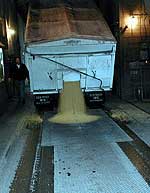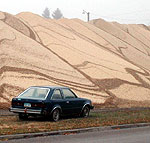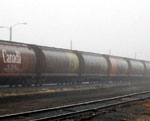By Bob Reha
Minnesota Public Radio
October 15, 2002
Farmers are always battling the weather, but 2002 will be remembered as a year of extremes. Areas of the Red River valley were swamped with heavy rains, while other areas were plagued with drought. Extreme conditions have hurt overall production, bumping crop prices up. For farmers with a good crop, this could be a year to make money.
| |
|
|
|
||
A line of semi-trucks waits at the Reynolds Co-op just south of Grand Forks, North Dakota. It's a cold, wet, foggy morning. If the weather was nicer, the line would be much longer. It's been that kind of year in Reynolds. Too much moisture hurt crops, and now it's slowing the harvest.
Paul Coppin, manager of the Reynolds Co-op, watches the weather just like the farmers.
"When it (the crop) doesn't come off in perfect condition, or the way we want it to come off, it makes it really hard for us to do business," says Coppin.
Weather dictates how much storage he'll need and how many workers he hires. Coppin says crops have recovered better than expected -- good enough for some farmers to harvest an average crop. But he says many are having sleepless nights.
"Every year ... they farm from year to year. They've got no cushion anymore, like they used to in years past," says Coppin.
| |
|
|
|
||
"It just makes it all the more intense. I mean these guys have to have a crop and they have to have a price for it."
Farmers in the Reynolds area are not alone. Poor crops around the world are forcing prices higher.
"That's always the case with agriculture -- that someone else's disaster is someone else's gain," says Dwight Aakre, farm management specialist at North Dakota State University.
"In a disaster year in terms of drought conditions for hay production, it means those on the outside of that drought who do have a good crop are going to make some money. And that's the same thing that is happening in the wheat situation," says Aakre.
The good news is prices are up. Wheat is almost $2 per bushel higher than a year ago. soybean and corn prices are also up.
| |
|
|
|
||
Farmer Mark Beedy has to coax his truck out of a wet field. A combine sits idle in his field, waiting for the ground to dry out. Half of Beedy's soybean crop is still in the field. Beedy, who farms south of Moorhead, says the year has been another roller coaster ride. He's already sold his wheat crop.
"I guess I was smart enough -- I took advantage of some prices that were better than last year's. If I had held on, I would have gotten considerably better," says Beedy. "And I can say with confidence that I'm not the lone ranger in that boat."
Beedy sold his wheat early this year, so he won't cash in on prices that have continued to rise. He's already planning for next year, hoping prices will stay high.
An hour south of Beedy's field, near Enderlin, North Dakota, the weather has been more cooperative. Keith Brandt, manager of the Enderlin Farmers Elevator, says farmers in the area have a good crop to market. He says these days he's seeing a lot of smiling faces.
| |
|
|
|
||
"They're going to do it strictly from the price of the commodity," says Brandt. "Uncle Sam is not giving any handouts at all this year. Just because of the way the price structure is, there will be nothing coming from Uncle Sam."
But Brandt says there are threats that could spoil the market. Getting the grain overseas could be a problem. Grain is shipped exclusively by rail to the West Coast, and Brandt says the recent lockout on the West Coast docks created a logjam. He says delivery of rail cars has fallen behind.
"They could easily erode to being 10 days behind, maybe two weeks behind," says Brandt. "Because ... grain doesn't have the priority as produce or other goods, they're going to get priority as far as what gets taken care of first."
Brandt worries that foreign customers who want to buy U.S. grain won't be able to get their ships loaded. He says if that happens they'll go somewhere else. He says once that customer is lost, you have to work a lot harder to get them back.




